Fruit and vegetable consumption and incident breast cancer: a systematic review and meta-analysis of prospective studies
- PMID: 34006925
- PMCID: PMC8292326
- DOI: 10.1038/s41416-021-01373-2
Fruit and vegetable consumption and incident breast cancer: a systematic review and meta-analysis of prospective studies
Abstract
Background: We conducted a systematic review and meta-analysis of prospective studies to clarify the relation of fruit and vegetable consumption with incident breast cancer.
Methods: We searched systematically PubMed and EMBASE databases up to November 2020 to include prospective studies that reported the association of fruit and vegetable consumption with incident breast cancer. The pooled relative risks (RRs) and 95% confidence intervals (CIs) were calculated for the highest versus the lowest category of total fruit and vegetable, total fruit and total vegetable consumption, as well as fruit juice and subgroups of vegetables in relation to breast cancer incidence, using a random-effect model.
Results: Total fruit and vegetable consumption was associated with lower overall (RR = 0.91, 95% CI = 0.87-0.95) and postmenopausal breast cancer risk (RR = 0.88, 95% CI = 0.79-0.99). Total fruit consumption was associated with lower overall (RR = 0.93, 95% CI = 0.88-0.99) and postmenopausal breast cancer risk (RR = 0.93, 95% CI = 0.87-0.99). Total fruit and vegetable intake were associated with 11% and 26% lower risk of oestrogen- and progesterone-receptor-positive (ER+/PR+) and -negative (ER-/PR-) breast cancer, respectively. Total vegetable consumption was associated with 27% lower risk of ER-/PR- breast cancer. Fruit juice consumption was associated with increased overall breast cancer risk (RR = 1.04, 95% CI = 1.01-1.07). We did not find significant associations for subgroups of vegetable intake and breast cancer risk.
Conclusions: These findings suggest that high total fruit and vegetable consumption are associated with reduced risk of overall, postmenopausal, ER+/PR+ and ER-/PR- breast cancer.
© 2021. The Author(s), under exclusive licence to Cancer Research UK.
Conflict of interest statement
The authors declare no competing interests.
Figures
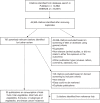

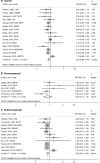

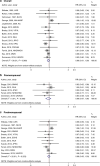
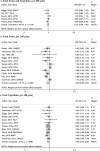
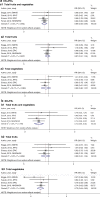
Similar articles
-
Vegetable and fruit consumption and the risk of hormone receptor-defined breast cancer in the EPIC cohort.Am J Clin Nutr. 2016 Jan;103(1):168-77. doi: 10.3945/ajcn.114.101436. Epub 2015 Nov 25. Am J Clin Nutr. 2016. PMID: 26607934
-
Fruit and vegetable intake and risk of breast cancer by hormone receptor status.J Natl Cancer Inst. 2013 Feb 6;105(3):219-36. doi: 10.1093/jnci/djs635. Epub 2013 Jan 24. J Natl Cancer Inst. 2013. PMID: 23349252 Free PMC article.
-
Fruit and vegetable intake and breast cancer risk defined by estrogen and progesterone receptor status: the Japan Public Health Center-based Prospective Study.Cancer Causes Control. 2013 Dec;24(12):2117-28. doi: 10.1007/s10552-013-0289-7. Epub 2013 Oct 4. Cancer Causes Control. 2013. PMID: 24091793
-
Fruit and vegetable consumption and risk of depression: accumulative evidence from an updated systematic review and meta-analysis of epidemiological studies.Br J Nutr. 2018 May;119(10):1087-1101. doi: 10.1017/S0007114518000697. Br J Nutr. 2018. PMID: 29759102
-
Fiber consumption and breast cancer incidence: A systematic review and meta-analysis of prospective studies.Cancer. 2020 Jul 1;126(13):3061-3075. doi: 10.1002/cncr.32816. Epub 2020 Apr 6. Cancer. 2020. PMID: 32249416
Cited by
-
Breast cancer: pathogenesis and treatments.Signal Transduct Target Ther. 2025 Feb 19;10(1):49. doi: 10.1038/s41392-024-02108-4. Signal Transduct Target Ther. 2025. PMID: 39966355 Free PMC article. Review.
-
Consumption of fruits and vegetables among adolescents in Arab Countries: a systematic review.Int J Behav Nutr Phys Act. 2023 Jan 9;20(1):3. doi: 10.1186/s12966-022-01398-7. Int J Behav Nutr Phys Act. 2023. PMID: 36624455 Free PMC article.
-
Breast cancer determinants in low- to upper-middle-income countries: an umbrella review of meta-analyses of observational studies and an urgent call for implementation science.BMC Cancer. 2025 Jul 1;25(1):1096. doi: 10.1186/s12885-025-14499-w. BMC Cancer. 2025. PMID: 40597060 Free PMC article.
-
Aronia melanocarpa L. fruit peels show anti-cancer effects in preclinical models of breast carcinoma: The perspectives in the chemoprevention and therapy modulation.Front Oncol. 2024 Oct 7;14:1463656. doi: 10.3389/fonc.2024.1463656. eCollection 2024. Front Oncol. 2024. PMID: 39435289 Free PMC article.
-
The Association between Circulating Carotenoids and Risk of Breast Cancer: A Systematic Review and Dose-Response Meta-Analysis of Prospective Studies.Adv Nutr. 2024 Jan;15(1):100135. doi: 10.1016/j.advnut.2023.10.007. Epub 2023 Oct 30. Adv Nutr. 2024. PMID: 38436219 Free PMC article.
References
-
- Sung, H., Ferlay, J., Siegel, R.L., Laversanne, M., Soerjomataram, I., Jemal, A. & Bray, F. Global Cancer Statistics 2020: GLOBOCAN Estimates of Incidence and Mortality Worldwide for 36 Cancers in 185 Countries. CA Cancer J. Clin.10.3322/caac.21660 (2021). - PubMed
-
- Rock, C. L., Thomson, C., Gansler, T., Gapstur, S. M., McCullough, M. L., Patel, A. V. et al. American cancer society guidelines on nutrition and physical activity for cancer prevention. CA Cancer J. Clin. 70, 245–271 (2020). - PubMed
-
- Farvid, M. S., Spence, N. D., Holmes, M. D. & Barnett, J. B. Fiber consumption and breast cancer incidence: a systematic review and meta-analysis of prospective studies. Cancer126, 3061–3075 (2020). - PubMed
Publication types
MeSH terms
Substances
LinkOut - more resources
Full Text Sources
Other Literature Sources
Medical
Research Materials

